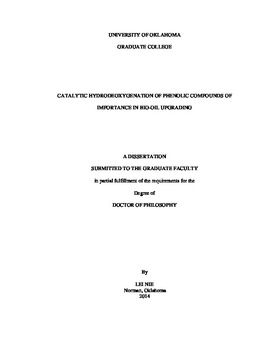| dc.description.abstract | Economic and environmental concerns including the increasing energy consumption and demand, ensuring energy security, reducing green-house gas emission and producing cleaner energy have caused tremendous interest in research and development on use of renewable energy resources such as biomass. Fast pyrolysis has proven to be a cost efficient method to convert biomass to liquid bio-oil which could be further upgraded to blend with conventional transportation fuels. Since the high oxygen content in fast pyrolysis bio-oil has brought bad properties such as instability during storage and transportation and low heating value. Hydrodeoxygenation (Hydrotreating), a refinery hydroprocessing technology, is cited to be an efficient technology to remove the excess oxygen in bio-oil. Moreover, during the process, the retention carbon in the bio-oil liquid as well as reduction of the hydrogen consumption is other important issue to investigate. Thus in the scope of this dissertation, a detailed study of the reaction kinetics and the mechanism of hydrodeoxygenation of phenolic compounds in fast pyrolysis bio-oil is presented. Also the understanding of the fundamental catalytic chemistry will be applied to tailor catalyst formulations to convert the model phenolics in bio-oil to higher value hydrocarbon products.
In this dissertation, a tautomerization reaction pathway for the hydrodeoyxgenation of m-cresol (a model phenolic compound in bio-oil) is proven, which has not been previously proposed in any previous literature. The tautomerization path starts with the tautomerization of m-cresol to an unstable ketone intermediate (3-methyl-3,5-cyclohexadienone). The fate of this intermediate is determined by the ability of the catalyst to either hydrogenate the carbonyl group or the ring. The former would be preferred over catalysts with oxophilic sites (Ni-Fe/SiO2, Pt/TiO2), while the latter would mostly occur over catalysts with a pure metallic function (Pt/SiO2, Ni/SiO2).
Hydrogenation of the carbonyl group produces a very reactive unsaturated alcohol (3-methyl-3,5-cyclohexadienol), which can be easily dehydrated to toluene. This dehydration step is driven by the formation of aromaticity. Thus, strong acid site is not required. By contrast, hydrogenation of the ring would result in 3-methylcyclohexanone, which can be further hydrogenated to 3-methylcyclohexanol. On supports that contain strong acid sites, which are active for dehydration of the corresponding alcohol, the formation of toluene would occur via dehydration of the alcohol and subsequent dehydrogenation. On the catalysts and conditions investigated in this dissertation, dehydration of the corresponding alcohol does not occur due to low acidity of the supports (SiO2, TiO2 etc.), so the only path to toluene is via hydrogenation of the carbonyl of the unstable ketone intermediate.
Catalysts formulation can be tailored by introducing oxophilic sites either by incorporating bimetallic catalysts or the metal support interaction. Oxophilic sites help improve the chemoselective hydrogenation of the carbonyl group of the unstable ketone intermediate thus dramatically increase the selectivity of hydrodeoxygenation. At the same time the hydrodeoxygenation reaction rate is increased. | en_US |
